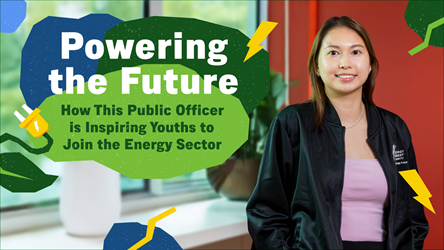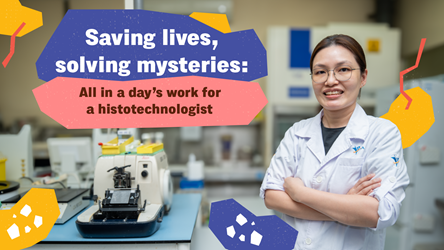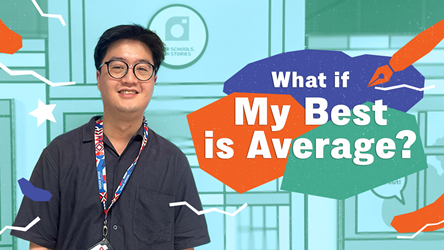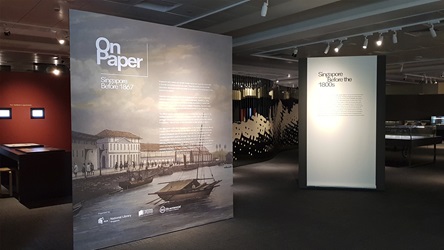Interview With The Content “Vampire”: Drawing Inspiration To Feed Ideas
*The following has been edited for length and clarity.

I’d been working at the libraries for two decades. It was my first job, other than working as a waiter to get some extra cash.
I was asked if I would be keen to join the library as a librarian, after finishing my English course at the University of York under a PSC scholarship.
Being of rather chill persuasion then and thinking books would be fairly harmless, I decided it would be a perfectly suitable position for me.
Of course, I had every single stereotype in my head about librarians and thought it might be nice to “roleplay” someone unassuming, bookish and nerdishly resourceful.
I ended up doing some of the most frightfully challenging projects that the library did: the first library@Orchard, the then new National Library Building and two of the strangest creativity workshops to come out of libraries — Ask Stupid Questions and Aspiration Pathfinder.
Those were before the Singapore Memory Project, which I feel defined my time in the National Library Board (NLB). It pulled together everything I had ever learnt about being a librarian — understanding the details of each story, just as I would for every book, and organising them into a form that is accessible to everyone else who hadn't lived those stories.
I had been thinking for some time about going someplace other than the library world. It was a bit of career wanderlust, having spent all my working life as a librarian. I wanted to know if I was good at something else. But the hardest thing was, I had no idea what I could do, or even what else I would be good at!
I decided I wanted a hand in shaping the cityscape of Singapore — something tangible, something hard. It led me to the Centre for Liveable Cities (CLC), which in turn led me to a project that was at the time staffed by the CLC — The Singapore Future Exhibition, which then became The Future of Us exhibition.
The move was very quick — it came even as I was in the NLB, in February 2015. So there really was no time at all before I was almost catapulted from a project on the past, to the as-yet-not-imagined project on our future.
I invariably end up with portfolios that I feel I am not ready for and have mortal fear of. Maybe that is how I thrive?
My dream — as yet unfulfilled — is to build a library of the future.
That would be a choreographed experience of content — one that would throw you off balance, inspire you to colour outside the lines, and in the most part, move you. Those ideas about libraries were also what I took with me to the biggest project with the most daunting schedule ever.

The most challenging thing in The Future of Us project was the sheer number of people, partners and content that had to be pulled together.
I have always been aware of the frailty of the “one-man show”. I started with a very small team in the CLC, but there was so much help and friendship across the Service, with our designers and very enlightened leaders of the project.
The CLC is very young and, as a result, very collegiate in spirit. There is a lot of dynamism and optimism that is very propulsive for me.
Through some miracle, the biggest and most complex project I have ever done was also blessed with people with just the right mix and temperament at all levels of the project. How else could we have done this in record time? Impossible.
If we were not careful, it could have ended up being a cornucopia of plans by numbers. But I was determined that it would be an experience, rather than an exhibition of panels.
So I started organising, like a good librarian, the content into categories, and then figuring out the most cinematic way to experience it.
Parts of The Future of Us came from 1939’s The Wizard of Oz, parts came from Hitchcock’s Rear Window.
The windows in every block of The Future of Us’ Home Tomorrow section are windows into the lives of the future. This came from the idea of Grace Kelly and James Stewart [in Rear Window] looking into their neighbours’ lives. That same voyeurism has been reframed into something like a looking glass into the future. The overall art direction for Home Tomorrow was developed from the tornado scene in The Wizard of Oz. The tornadoes that connected the ground to the sky are reimagined as the vertical homes reaching up to the sky.
I love books. I love movies even more. One taught me to go beneath the headlines and to constantly battle against the tyranny of the singular thought or maybe binary thinking. The other told me to always reach for emotion in my work — the kind that moves people and draws them together rather than apart.
I am also very much in love with history; I am intrigued by the idea that events in the past was really not set by someone else or by fate — it was the outcome of so many interrelated people’s actions and choices.
That both frightened me and gave the team the principle — surely the future is not set too. It will be created and directed by the summary of all our choices.
That was how I connected the past to the future — memory of a nation and its choices, to the future of us.
I have been stalking the exhibition halls since December 1 — in fact, I felt something inside me would die if I didn’t show up every day — hiding amongst the audiences, seeing their reactions to the final product, listening to their debates on the future.
The result of people stopping to talk about the future, rather than just walking away — that is my measure of the exhibition’s success.
I am obsessed with the idea of wearable art and the many geniuses and eccentrics in the fashion industry.
It made me realise that maybe thinking and being different could be an advantage, not a liability.
My interest in fashion started with the September 1989 issue of Vogue, with Naomi Campbell on the cover. What struck me was how ornate and exquisite the clothes and the art direction were. Every frame was almost like an imagined art piece. I plunged into fashion history after that.
I have a very tragic taste in designers. I adore the late Alexander McQueen — his clothes have a combination of savagery and history. Also, the previous designer of Balmain, Christophe Decarnin, who revitalised the fashion scene with his pop-infused punk rock couture. He left the industry and apparently checked himself into a mental hospital.
I loved how much romance, attitude and craftsmanship there is in their world. And I wanted to emulate that.
Karl Lagerfeld, the creative director of Chanel, is known for being a “fashion vampire” — the ability to take influences from others and spin it into something accessible.
That became my model: a vampire of content, taking it all in and choreographing the strands into a coherent narrative.
I have been called “child-like”, “alien”, “exotic” by many — but never in a malicious way. Strangely, being who I am has advanced me always. It puzzles me to this day.
I think the Service has been underestimated in its capacity for the weird. Perhaps I am not weird enough — or maybe the librarian in me lends the weirdness a touch of the unthreatening.
I don’t ever stop thinking about work. I aspire to be a master copier of trends, of loves, of the most original thoughts. Most of these come from movie and books that I enjoy — so every great movie that I watch, I will think about it for days and what it means for what I am doing.
What’s in my future? I hope it’s something terrifying that will make me question why I ever agreed to do it. Something that will invariably change my life again.
- POSTED ON
Mar 2, 2016
- TEXT BY
Gene Tan
- PHOTOS BY
Teck, Lumina
-
Profile
What If My Best Is Average?









